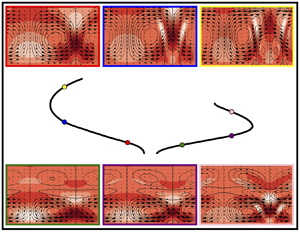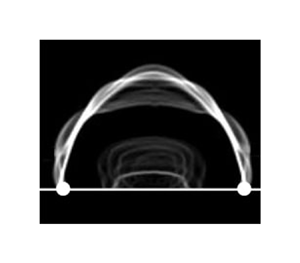Graphical abstract from Lu, R., Wang, Z., Salsac, A., Barthès-Biesel, D., Wang, W. & Sui, Y. 2021 Path selection of a train of spherical capsules in a branched microchannel. J. Fluid Mech. 923, A11. doi:10.1017/jfm.2021.571.
JFM Rapids
Hydrodynamics of large wave energy converter arrays with random configuration variations
-
- Published online by Cambridge University Press:
- 21 July 2021, R1
-
- Article
- Export citation
Nonlinear fluid damping of elastically mounted pitching wings in quiescent water
-
- Published online by Cambridge University Press:
- 22 July 2021, R2
-
- Article
- Export citation
Travelling waves in elliptic pipe flow
-
- Published online by Cambridge University Press:
- 22 July 2021, R3
-
- Article
- Export citation
Bifurcation analysis of bubble-induced convection in a horizontal liquid layer: role of forces on bubbles
-
- Published online by Cambridge University Press:
- 27 July 2021, R4
-
- Article
- Export citation
Flow rate–pressure drop relation for shear-thinning fluids in narrow channels: approximate solutions and comparison with experiments
-
- Published online by Cambridge University Press:
- 30 July 2021, R5
-
- Article
- Export citation
Microtomographic particle image velocimetry measurements of viscoelastic instabilities in a three-dimensional microcontraction
-
- Published online by Cambridge University Press:
- 02 August 2021, R6
-
- Article
-
- You have access
- Open access
- HTML
- Export citation
JFM Papers
Linear and nonlinear sensor placement strategies for mean-flow reconstruction via data assimilation
-
- Published online by Cambridge University Press:
- 21 July 2021, A1
-
- Article
- Export citation
A wide-spacing approximation model for the reflection and transmission of water waves over an array of vertical obstacles
-
- Published online by Cambridge University Press:
- 21 July 2021, A2
-
- Article
-
- You have access
- Open access
- HTML
- Export citation
Dynamic and stationary shapes of rotating toroidal drops in viscous linear flows
-
- Published online by Cambridge University Press:
- 21 July 2021, A3
-
- Article
- Export citation
Liquid film dynamics with immobile contact line during meniscus oscillation
-
- Published online by Cambridge University Press:
- 21 July 2021, A4
-
- Article
- Export citation
Drop impact on solids: contact-angle hysteresis filters impact energy into modal vibrations
-
- Published online by Cambridge University Press:
- 21 July 2021, A5
-
- Article
- Export citation
On the role of roughness valleys in turbulent Rayleigh–Bénard convection
-
- Published online by Cambridge University Press:
- 21 July 2021, A6
-
- Article
-
- You have access
- Open access
- HTML
- Export citation
Exact coherent structures and shadowing in turbulent Taylor–Couette flow
-
- Published online by Cambridge University Press:
- 23 July 2021, A7
-
- Article
- Export citation
Reduction of turbulent skin-friction drag by passively rotating discs
-
- Published online by Cambridge University Press:
- 22 July 2021, A8
-
- Article
- Export citation
Weakly nonlinear shape oscillations of inviscid drops
-
- Published online by Cambridge University Press:
- 22 July 2021, A9
-
- Article
- Export citation
Scattering of entropy waves into sound by isolated aerofoils
-
- Published online by Cambridge University Press:
- 22 July 2021, A10
-
- Article
-
- You have access
- Open access
- HTML
- Export citation
Path selection of a train of spherical capsules in a branched microchannel
-
- Published online by Cambridge University Press:
- 22 July 2021, A11
-
- Article
-
- You have access
- Open access
- HTML
- Export citation
Vortex dynamics on a Möbius strip
-
- Published online by Cambridge University Press:
- 22 July 2021, A12
-
- Article
-
- You have access
- Open access
- HTML
- Export citation
Surface waves along liquid cylinders. Part 2. Varicose, sinuous, sloshing and nonlinear waves
-
- Published online by Cambridge University Press:
- 27 July 2021, A13
-
- Article
- Export citation
Stability analysis of a chemotaxis–convection–diffusion coupling system with the roles of deformed free surface and surface tension
-
- Published online by Cambridge University Press:
- 27 July 2021, A14
-
- Article
- Export citation




































































